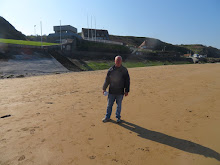Sixty-six years ago today, Allied forces stormed the beaches of Normandy in the greatest amphibious landing ever, successfully breaching Hitler's Fortress Europa enroute to an historic meeting with Soviet troops on the Elbe River in Germany less than a year later. Some commentators say that ancient history flowed into that date and modern history flowed out of it.
It was an enormous, complex enterprise involving hundreds of thousands of men. Allied airborne troops preceded the troops splashing ashore at daybreak by several hours.
Ever heard of Sergeant M.C. Thornton of the British Sixth Airborne Division? This one man might have changed the course of history that night.
The German plan to throw the invaders back into the sea depended upon Panzer units counterattacking the left flank of the landings while the Allies were still on the beaches. To do this, their tanks had to cross the Orne River and the adjacent Caen Canal in order to get at the British.
Ever heard of Sergeant M.C. Thornton of the British Sixth Airborne Division? The road to modern history might have flowed through his foxhole early that morning.
Maybe you've heard of Omaha Beach, where the Americans almost came to grief; probably you haven't heard of Pegasus Bridge, where the British almost came to grief. Historian Stephen E. Ambrose wrote a book about the Sixth Airborne's early morning battle at the bridge over the canal, seeking to deny the Germans the only road their Panzers could take across the water barrier blocking their armor from the Allied beaches.
The Allies didn't simply blow these bridges six miles off the beaches because they wanted them so their troops could use them to break out of Normandy and head east towards Germany. Just after midnight British paratroopers captured the bridges, but their thin ranks had to hold them until troops landing later that day could come to their aid or else the intact bridges could turn into an avenue for furious Axis armored counterattacks.
In the early morning of June 6th, the Germans knew something was up. Glider troops had landed and heavy firing was going on.
The local German commander sent his tanks along with some infantry in the dark to investigate the confused situation at the bridges. As they approached the Pegasus (Benouville) Bridge, a single company of British troops who had landed practically on top of the bridges in gliders just after midnight waited with no antitank weapons save one Piat gun, the British equivalent of the American bazooka.
The noisy German tanks were moving slowly and cautiously towards the bridge, with the foot soldiers following. Sgt. Thornton was in a fire pit with his Piat gun 30 yards off the bridge entrance way, near the end of the weapon's effective range.
All other weapons the lightly armed British paratroopers had with them were useless against buttoned down tanks. The German troops should have preceded the tanks, but the German response was hesitant and uncertain that first night.
"The Piat actually is a load of rubbish, really." Thornton said years later. "Even fifty yards is stretching its range."
"Another thing is, you must never, never miss." It was too time-consuming to reload and the gunner would be killed by counter fire if he missed.
The British held their fire as the tanks approached. Shaking like a leaf, Thornton took aim and fired at the lead tank as it turned towards the bridge.
In typical British understatement, Thornton described what happened. "I hit him right right bang in the middle."
The round penetrated and the tank went up, and burned slowly for the rest of the night, cooking off rounds occasionally. The rest of the tanks retreated, not to return that night.
A British paratrooper colonel came up later towards the burning tank with a few additional troopers as reinforcements. "What the bloody hell's going on up there," he asked Thornton.
"It's only a bloody old tank going off," Thornton replied, "but it's making an awful racket."
With the bridges leading directly to the Normandy Coastal Road in Allied hands, German armored counterattacks were forced to divert far inland around Caen and they were committed piecemeal, with ineffectual results. Eastern Front veteran Colonel Hans A. Von Luck, commanding the elite 125th Panzer Grenadier Regiment of the 21st Panzer Division which was east of Caen at the time, "contends that if those bridges had been available to him, he could have crossed the Orne waterways and thrown his regiment into the late-afternoon D-Day counterattack. The attack, by the 192d Regiment of 21st Panzer, almost reached the beaches. Von Luck feels that had his regiment also been in that attack, 21st Panzer would surely have driven to the beaches. A panzer division loose on the beaches..." Pegasus Bridge, p. 125.
Put yourself in Sgt. Thornton's foxhole at 2 a.m. on June 6th in Normandy in 1944, staring at a German tank 90 feet away that hasn't spotted you in the dark. One shot is all you will get, and if you shoot and miss, the tank will kill you. Even if you shoot and hit the tank, it or the second tank might kill you anyway. The small detachment of British troopers nearby cannot help you in this solitary duel. The British troops who will pour ashore hours later on Sword Beach are depending upon you to do your duty, to keep these tanks off their flank. Your trembling finger slowly tightens on the Piat gun trigger as the iron monster noses forward, its cannon swiveling looking for a target.
When interviewed decades later by Stephen Ambrose for Pegasus Bridge, Thornton told him, "Whatever you do in this book, don't go making me a bloody hero."
Ambrose replied, "Sergeant Thornton, I don't make heroes. I only write about them."
Subscribe to:
Post Comments (Atom)

1 comment:
Thank you so much for this beautiful Article
Post a Comment